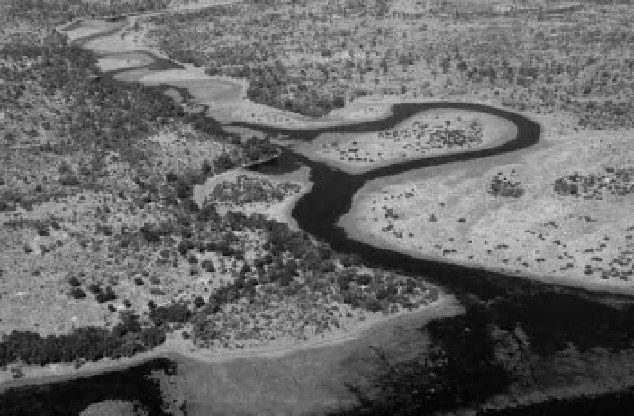Geoscience Reference
In-Depth Information
to provide equitable solutions to complex man-
agement arrangements.
The Okavango River delta is one such case
where cross-border troubles between Botswana
and Namibia are exacerbated by conl icts over
scarce water resources in this dry landscape
(International Rivers Network 2010). The desig-
nation of the Makgadikgadi Salt Pans (into
which the Okavango River eventually drains) as
a protected Ramsar site also complicates joint
protection efforts. The Okavango wetland is a
seasonally i lled inland delta for the Okavango
River, which has its headwaters in western
Angola and makes its way through Namibia
before disappearing in the midst of Botswana's
Kalahari Desert. The river weaves a maze of
lagoons, islands, and channels (Fig. 14-17)
before vanishing in the desert (Fig. 14-18). This
landscape and the rich soda deposits left behind
as the water evaporates or dries into the desert
sustain a unique ecosystem famous for wildlife,
including elephants (Fig. 14-19) and hundreds
of bird species (Fig. 14-20).
Both bilateral and multilateral agreements
have played a role in the management of the
Okavango River basin. One such tripartite agree-
ment, the Permanent Water Commission on the
Okavango reached by Namibia, Botswana, and
Angola has so far performed adequately as it
seeks to share water resources equitably across
borders (Okavango Commission (OKACOM)
2010). In such cases, governmental and non-
governmental mediators like the non-proi t
Green Cross International play important roles
in creating the atmosphere for fair solutions or
providing technical and scientii c assistance. In
the case of the Okavango, the Global Environ-
mental Facility has also funded projects and
provided management assistance.
The Pantanal provides yet another example of
the need for multilateral arrangements for
wetland protection. The Pantanal is part of the
upper Paraguay River basin (in Bolivia, Paraguay,
and Brazil) and Mato Grosso (Brazil). It extends
over
360,000 km
2
and comprises riverine, palus-
trine, and lacustrine wetlands ecosystems (Banks
1991). The larger Paraná-Paraguay River system
is to be the main focus for development in the
coming decades (Wais and Roth-Nelson 1994).
Several hydroelectric projects are either being
planned or have already been built across the
river system to provide l ood controls on the
rivers, develop an internal transportation corri-
dor, and boost growth in the interior of these
countries. This, along with increased population
and agricultural and industrial development
pressures will likely change the Pantanal's habitat
signii cantly (Swarts 2000; Junk et al. 2009).
>
Figure 14-17.
Aerial view of a meandering channel in the Okavango River delta during the dry, cool, winter
season. Photograph taken from a small plane; courtesy of M. Storm.





